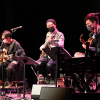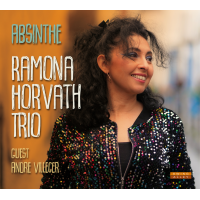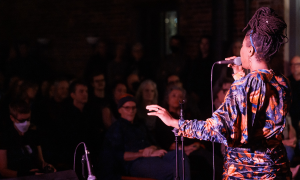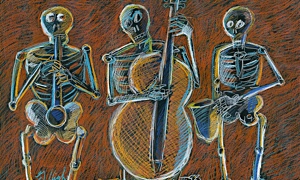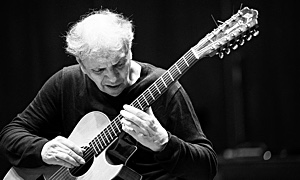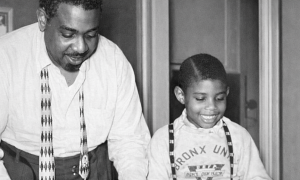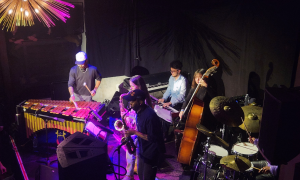Home » Jazz Articles » What is Jazz? » Jazz Returns to Seattle's Central District: Two Evenings...
Jazz Returns to Seattle's Central District: Two Evenings of Black Brilliance

Courtesy Lisa Hagen Glynn
What we're trying to do is cultivate a sound
—Giveton Gelin
A fully integrated jazz nightclub scene was a rarity on a national scale, perhaps only fully realized along Jackson Street in Seattle, and Central Avenue in Los Angeles. The respective scenes attracted Black musicians from the Jim Crow south, in search of work and the ability to achieve artistry untethered by the tyranny experienced in southern music cities such as Atlanta, Memphis and New Orleans. Even Jelly Roll Morton lived a spell in Seattle, as early as 1919. Neither prohibition, nor the Great Depression could cap the enthusiasm of the city's bottle clubs along Jackson Street, many of which were operated by Black entrepreneurs. The most notable of these club owners was E. Russell "Noodles" Smith, who along with partner Burr "Blackie" Williams would operate the legendary Black and Tan nightclub in the basement of the aforementioned "miracle" on the corner of 12th and Jackson. In 1920, they opened The Entertainers Club in the upstairs portion of the building, and the late night Alhambra club in the basement. The downstairs nightspot then was renamed the Black and Tan, noted for its integrated, black and white clientele. Smith had arrived in Seattle in 1909, and had a sharp eye for business. With the town rife with cash from the shipyards and lumber mills following the Great War, Jackson Street was able to withstand the onslaught of prohibition, and later as mentioned, the Great Depression.
By the 1980s, some fifteen years after the closing of the Black and Tan in 1966, most of the buildings that housed the vaunted Jackson Street night spots were razed and replaced by strip malls. As southeast Asian immigrants began to arrive after the Vietnam War, the neighborhood now bordered by I-5 to the west, became the thriving center of the Southeast Asian community in Seattle. Little Saigon earned its nickname in 1984 when Southeast Asian merchants created their own commercial center east of the International District. Through it all, that most hallowed of locations in the history of Seattle jazz managed to still stand, today housing Khang Hoa Duong, a Vietnamese grocery and herb store, and an assortment of small businesses.
The Covid-19 pandemic and subsequent shutdown was heavily impactful on Little Saigon. In front of Khang Hoa Duong, a veritable bazaar of stolen goods covers the adjacent sidewalk. A walk through the gauntlet reveals everything sold from laundry soap to bicycles. One vendor easily admitted that his wares were stolen, but "untraceable." The area has been marked by violence, including gunshot victims. The Metro bus stop at the location is completely occupied by campers and vendors. It's hard to imagine that as late as the mid-'60s, this neighborhood was a thriving segment of the city's entertainment hub, and in particular, where jazz and rhythm and blues were the sounds in residence on the edge of the Central District, just north of the International District.
The history of Seattle jazz, and the Jackson Street jazz scene, is extensively chronicled in Jackson Street After Hours (Sasquatch, 1993), written by long-time Seattle Times and Downbeat jazz writer, Paul de Barros. A volume chronicling Seattle jazz from 1960 forward is in the works. The neighborhood still bears markings of its jazz heyday, with a marker across the street from the Black and Tan site, a housing development and street named after iconic Seattle vocalist Ernestine Anderson, and Seattle JazzEd developing a site in the historic, traditionally African American Central District.
Today's jazz scene in Seattle has changed dramatically. Of course jazz is even more marginalized economically now than it was in the 1950's, when jazz was art performance music as it is today, but still commercially viable. It is certainly more financially stressed than it was in the decades preceding World War ll, when jazz was dance music, and the popular music of its time.
In the 1960's, Pioneer Square bore the brunt of the action, with clubs like The Penthouse and Pete's Poop Deck, and on into the 1970's with Parnell's, the Pioneer Banque and the New Orleans. Anderson briefly took over Parnell's in Occidental Square, and rebranded it as Ernestine's. John Dimitriou's journey with Jazz Alley began in the U District and migrated to Belltown, a neighborhood that also saw the twenty six year run of Tula's, the home base for the local Seattle scene over that period of time. Jazz Alley recently celebrated its 40th anniversary.
With the closing of Tula's in October of 2019, Seattle's once burgeoning resident jazz culture was in danger of being swept into the dustbin of the city's jazz past. While touring acts still had Jazz Alley and the Triple Door to rely on, the resident scene was down to The Royal Room, a multi-genre club managed by Wayne Horvitz, Egan's Ballard Jam House, a forty five seat venue in the Ballard neighborhood and several smaller gigs that bore no real resemblance to jazz culture. The local non-profit, Earshot Jazz, took up some of the slack, consciously embracing local musicians. In October of 2021, Seattle trumpeter Thomas Marriott, perhaps the city's most recognizable jazz musician, stepped up and offered The Seattle Jazz Fellowship, a non-profit designed to provide a venue for resident musicians and jazz fans, and give a much needed jumpstart to the tradition of jazz mentorship and community. Currently, SJF operates one night a week at Vermillion Art Gallery & Bar on Capitol Hill, with ambitions to cover five nights a week at a permanent location.
Three blocks west of Jackson Street, and five blocks north of the Black and Tan site, is the home of Langston, a local organization dedicated to cultivating Black brilliance by promoting artistic expression and encouraging artistic excellence. The 501 (c)(3) engages in cultural education, practicing community and inclusivity. The building where the organization is housed, includes an impressive, 1915 Byzantine style domed performing arts theatre that originally housed the synagogue of the Orthodox Jewish congregation Chevra Bikur Cholim, now Bikur Cholim Machzikay Hadath. The congregation was thriving in the early days of Jackson Street.
While Langston had hosted jazz events under the banner of Earshot Jazz in previous years, one weekend in October of 2021 stood out not only in terms of jazz returning to its roots neighborhood in Seattle, but in terms of unity and healing after the isolation of the Covid-19 pandemic. The month-long Earshot Jazz Festival delivered in bringing two brilliant, young Black artists to Langston in a seemingly emblematic gesture of historic recognition and continuing the spiritual legacy of the building itself.
Twenty two year old, Nassau born and raised trumpeter Giveton Gelin, and twenty three year old alto saxophonist, Philadelphia native Immanuel Wilkins, are generational talents having a major impact on modern jazz music. The divergence of these two young, brilliant Black artists, in the heart of Seattle's traditional African American neighborhood bore great significance to those keenly aware of the city's storied jazz history. It also inspired those not quite as aware of Seattle's one hundred year legacy in jazz, to dig deeper and more fully appreciate the rich culture of the city where they reside.
"This was the fourth year of our more formal collaboration with the fairly new non-profit, Langston Seattle, though we've presented quite a few memorable concerts in the building over the past 25 plus years. Grateful to Tim Lennon and Jazmyn Scott of Langston and super proud to help keep the fire and invention of jazz alive in Seattle's Central District. We're committed to enriching this enduring relationship," says Earshot Executive Director, John Gilbreath.
Pianist Micah Thomas completed the trifecta. The twenty two year old pianist manned the keys for both Wilkins and Gelin, all three having found their way to the Juilliard School of Music in circuitous fashion over the past four years. While Thomas' hometown of Columbus, Ohio may not inspire visions of jazz grandeur, Wilkins' dues paying on the potent Philadelphia jazz scene, and Gelin's self-taught journey rooted in the Bahamas, basked all three in the oral tradition of jazz, paying dues with community elders, before entering the hallowed halls of Juilliard. All three released debut recordings in and around the pandemic, with Wilkins signing with Blue Note Records and releasing the Jason Moran produced Omega (BlueNote, 2020) to great acclaim. Gelin's True Design (Self Released, 2020) is equally compelling, and features both Thomas and Wilkins. Thomas' riveting live trio recording, Tide (Self Released, 2020), provides the eclectic pianist ample space to fully display his wares. The two days of music not only seemed a sure bet in terms of quality of musicianship and composition, but held the possibility of something truly special occurring as a result of the joyous juxtaposition of music, history and culture.
Wilkins took the Langston stage with bassist Tyrone Allen II and Thomas, adding drummer Mike Mitchell at the last minute. The energetic Mitchell, a dynamic proponent of gospel drumming, added an interesting twist to the quartet. Wilkins certainly responded positively, offering long, almost relentless solos that nonetheless bore intriguing melodic passages. Thomas was visually glued to Mitchell for much of the performance, with his comping working in angular balance with the drummer's mad, swinging style.
The tendency of virtually all young musicians is to fall back on speed and chops—all four of the quartet's members certainly had plenty of that. The set was burning from the outset, yet with a striking maturity one might not fully expect from a crew of recent Juilliard grads. There was so much talent to be tapped on that evening, yet it was dispensed with grace, fire and wisdom. Wilkins' composition "Omega" was the emotional zenith of the concert, despite being performed last. There was no "performance arc," as one might expect. The meteoric expanse of energy just continued to gain momentum, with Mitchell providing added impetus to an already scorching assemblage.
Wilkins is testament to the high state of the alto saxophone in modern jazz today. There is not a discernible stylistic trend mind you, but exploratory playing that has been achieved more often on tenor is no stranger to the alto in this day and age. The trio of Wilkins, Caleb Wheeler Curtis and Miguel Zenon, for example, are of disparate approaches. Wilkens has a sense about his playing that, while connected deeply to the jazz tradition, has a storytelling quality to it that engages the listener, no matter where Wilkins takes them in the moment. He thoughtfully works his way through the changes, his phrasing unfolding in a prose-like manner. His opening phrase for his extended solo on "Omega," resonated like birdsong from the beginning, the spacious quality of the room adding dimension to his sound as well. Most impressively, the altoist shows great maturity and humility as a bandleader. When Thomas ventured into a solo, the band suddenly became his trio, with Wilkins graciously stepping out of the spotlight, visibly delighted with the goings on all around him. Through original tunes, such as "Ferguson," and "Warrior," Wilkens allowed his bandmates to step into his imaginative harmonies and contribute their personal, relentless melodicisms.
As it would be for Giveton Gelin and his bandmates the following evening, Wilkins' performance was in a way, like going back in time. After having composed, rehearsed and recorded his music for a BlueNote release, he had to wade through the muck of life during the Covid-19 shutdown, waiting patiently to finally perform his music in front of a live audience. On a rainy, October in Seattle evening, a lot of emotion spilled out of the collective mind of this stunning quartet.
Gelin's prodigious talents have been apparent since his arrival in New York, eventually landing at Juilliard. He is a self-taught player from the Bahamas, yet at age twenty two, he is touring after releasing his debut album. He first spent time at Oberlin Conservatory studying with Dr. Eddie Henderson, before his sojourn to New York, there benefiting from the tutelage of trumpeters Roy Hargrove, Wynton Marsalis, Nicholas Payton and Ralph Peterson. While he is certainly a musical gatherer of sorts, Gelin is aware of a sound he is cultivating along with his mates Wilkins and Thomas. Gelin's performance passed through a series of interludes that connected the creative dots of an evolving sound.
For Gelin's set at Langston, Thomas remained the constant, energetic and melodically focused center of activity. Striking, as it had been the night before, was the very fact that two bands, led by young, brilliant Black jazz artists were opening the door to the next generation of jazz a scant three blocks from where iconic Seattle songstress Ernestine Anderson sang in a band that included pianist Ray Charles and trumpeter Quincy Jones. While jazz music has continued to evolve since the bebop movement of that era, Gelin's playing, and more specifically, his sound, bore the marks of New Orleans, of the blues. His lyrical ability to play just behind the beat and swing freely, is an attribute that defies any categorization by style, and defines in a true sense that which jazz music is-a great Black American art form carried forward around the world in unity. Gelin's style is more swinging than, for example, the approach of Ambrose Akinmusire, perhaps the most influential trumpeter on the current scene. He is connected to the entire timeline of the jazz tradition, still sounding very modern in the process.
Tenor saxophonist Morgan Guerin, bassist Phillip Norris and drummer Adriel Vincent-Brown joined Gelin for his Seattle debut. Gelin's playing was thoughtful, unusually mature for an artist who appears so strikingly young onstage. His persona after the performance was the same—thoughtful, mature, expressive and to the point. Beginning with a piano and trumpet interlude, the band strolled into a swinging post-bop mindset. Gelin connected melodic phrases with fluid runs, stepping aside for Guerin and Thomas' interpretive contributions on Sonny Rollins' "Grand Street," and Gelin originals "Inner Perception," and "The Worshipper." By the time the band played Gelin's "True Design," it had reached peak efficiency. Thomas appeared to be a bit more energetic on this his second performance in as many days. His solos were a bit more on the edge in explore mode. The quintet handled itself like a veteran touring band, playing with elegance in an all inclusive musical conversation.
In a room that has housed the prayers of many, two consecutive evenings of ensembles led by two young, brilliant Black artists playing at such a high level, seemed as a bridge between two very different eras in this historic neighborhood. That they were playing jazz, made the weekend truly magical. America's only original art form is a Black American art form. Its presence on Jackson Street and throughout the city's traditionally Black Central District has been revived, at least for a few weeks out of the year, by this productive cultural partnership between Earshot Jazz and the Langston Hughes Performing Arts Institute. In the new century of jazz, the music is played throughout the city. Jazz Alley, the city's prime time player is in Belltown, the Seattle Jazz Fellowship currently meets on Capitol Hill. Earshot's current digs at Town Hall Seattle are on First Hill, Egan's in Ballard, the North City Bistro is near the city line in Shoreline. Yet still, you can hear the faint whispers of history on Jackson Street, and throughout Central Seattle. The importance of recognizing and remembering this rich heritage is extremely important in understanding where the music stands in the city today. It is a clear image of the imagination and creative spirit of a city that has always been a bit of a remote outpost, yet with an alluring beauty unlike any other American city. It informs us of what the jazz community in Seattle can achieve today, in terms of artistry and the support systems that uphold it.
As the crowd exited the building, rain poured torrentially almost on cue. Walking out to Jackson Street under the cover of stately maple trees, the music still resonating within, those ghostly voices of the past begin to speak. Thoughts of late night jam sessions at the Black and Tan, of artists like Count Basie, Duke Ellington, Ernestine Anderson and Ray Charles who performed at the fabled nightspot run through one's mind. If you are mindful of the legacy on and around Jackson Street, you can feel it as you walk past the very building where this magic occurred, obscured by the travail of current times.
It was Saturday night, yet not a soul was seen in what used to be the city's liveliest late night playground. The driving rain was pouring like a river down the hill on Jackson Street, over streetcar tracks and empty car lanes, swiftly headed towards the Salish Sea. Many of the southeast Asian eateries that dot the strip malls along Jackson Street have shuttered since the onset of the pandemic, yet to reawaken a neighborhood in the throes of difficult times. While the Earshot events at Langston, and the annual Jackson Street Jazz Walk are insightful immersions into our storied past, the events lose value if we do not use them to assist in the revitalization of Seattle's vibrant jazz scene here in 2021. While the creative spirit still burns brightly in clubs and concert halls across the city, the modern, regressive economic model that is currently employed leaves few opportunities for art to thrive, for innovation to take flight. The importance of supporting organizations like Earshot Jazz, and for the sake of resident jazz musicians, the Seattle Jazz Fellowship, is paramount in this mindset. The music itself crosses all sociological lines, embraces the precious intersections that it encounters and unifies its participants in the light of beauty and the soul of community. That is the reality of now, a step forward from the grand history of jazz in Seattle and the legacy of Jackson Street.
A brilliant young alto saxophonist from Philadelphia and an enormously talented young Bahamian trumpeter arrived in the heart of the Central District over two days and showed us what artistry is, how it is a step beyond musicianship. To those of us who frequent live jazz performances, the sound being cultivated on the Langston stage seemed like a storm gathering strength, showing a clear path for the present and future of jazz. Those not acquainted as intimately with world class jazz musicians seemed enthusiastically stunned. The sheer virtuosity attached to creative insight and emotional release was an experience that would change the way some in the audience would view music going forward. It was an intrusion of beauty and an elevation of spirit.
Jazz is as much a community, as it is a musical art form. In Seattle, world class resident musicians such as Marriott, Greta Matassa, Jay Thomas, Xavier Lecouturier and Marc Seales perform on stages around the city every night. There are, of course, many more. In many ways, it is exactly as it was on Jackson Street some ninety years ago. There are those inspired to play, and those curious enough to listen. There is a wave of young jazz musicians rising as jazz fans are vaccinated and able to attend live performances. Jam sessions are abundant, and a local jazz fan can for twenty bucks, catch two sets at Vermillion, courtesy of the Seattle Jazz Fellowship. You may want to help out the club and have a drink, perhaps buy a CD from time to time. Our jazz predecessors on Jackson Street left us much more than a musical legacy. Jazz is social music, driven by community. This beautiful intersection of humanity united by the music is the true legacy that continues to move forward, and invites engagement. It is a story that began a century ago and continues to be written.
Tags
What is Jazz?
Immanuel Wilkins
Paul Rauch
United States
Washington
Seattle
Jelly Roll Morton
Ernestine Anderson
Wayne Horvitz
Thomas Marriott
Giveton Gelin
Tyrone Allen
Mike Mitchell
Eddie Henderson
wynton marsalis
Nicholas Payton
Ralph Peterson
Ray Charles
Quincy Jones
Morgan Guerin
Phillip Norris
Adriel Vincent-Brown
Greta Matassa
Jay Thomas
Xavier Lecouturier
PREVIOUS / NEXT
Immanuel Wilkins Concerts
Support All About Jazz
 All About Jazz has been a pillar of jazz since 1995, championing it as an art form and, more importantly, supporting the musicians who make it. Our enduring commitment has made "AAJ" one of the most culturally important websites of its kind, read by hundreds of thousands of fans, musicians and industry figures every month.
All About Jazz has been a pillar of jazz since 1995, championing it as an art form and, more importantly, supporting the musicians who make it. Our enduring commitment has made "AAJ" one of the most culturally important websites of its kind, read by hundreds of thousands of fans, musicians and industry figures every month.




